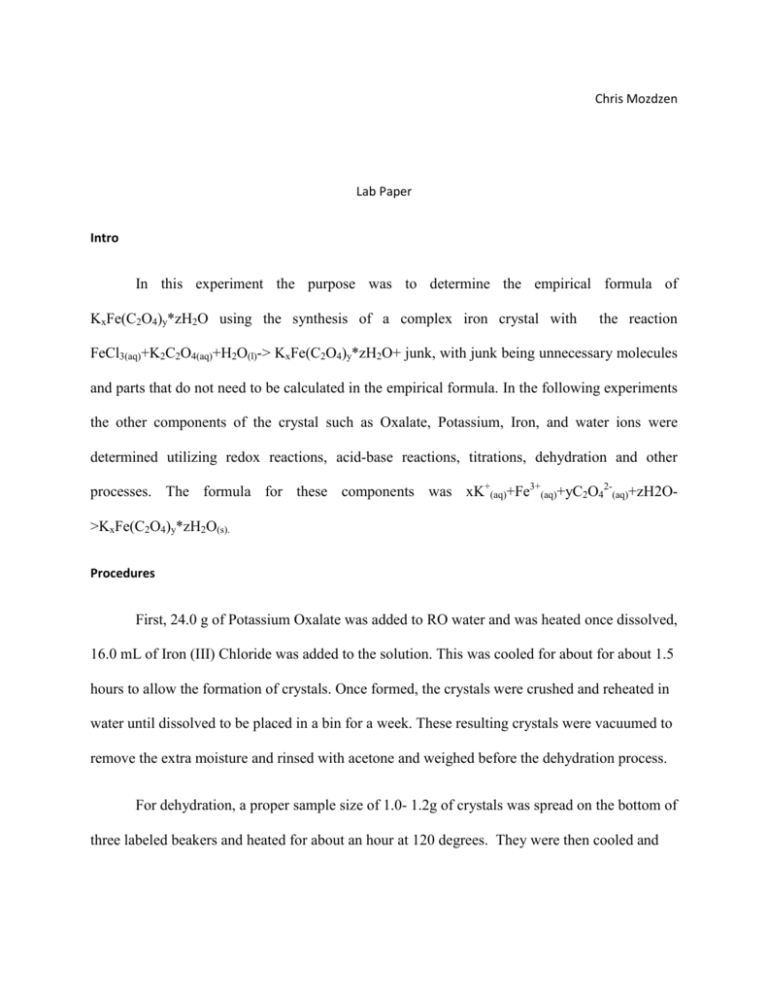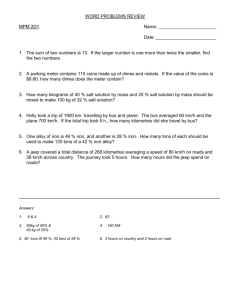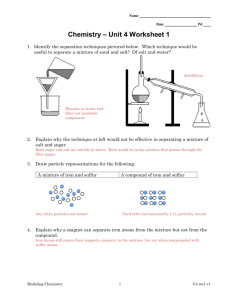In this experiment the purpose was to determine the empirical
advertisement

Chris Mozdzen Lab Paper Intro In this experiment the purpose was to determine the empirical formula of KxFe(C2O4)y*zH2O using the synthesis of a complex iron crystal with the reaction FeCl3(aq)+K2C2O4(aq)+H2O(l)-> KxFe(C2O4)y*zH2O+ junk, with junk being unnecessary molecules and parts that do not need to be calculated in the empirical formula. In the following experiments the other components of the crystal such as Oxalate, Potassium, Iron, and water ions were determined utilizing redox reactions, acid-base reactions, titrations, dehydration and other processes. The formula for these components was xK+(aq)+Fe3+(aq)+yC2O42-(aq)+zH2O>KxFe(C2O4)y*zH2O(s). Procedures First, 24.0 g of Potassium Oxalate was added to RO water and was heated once dissolved, 16.0 mL of Iron (III) Chloride was added to the solution. This was cooled for about for about 1.5 hours to allow the formation of crystals. Once formed, the crystals were crushed and reheated in water until dissolved to be placed in a bin for a week. These resulting crystals were vacuumed to remove the extra moisture and rinsed with acetone and weighed before the dehydration process. For dehydration, a proper sample size of 1.0- 1.2g of crystals was spread on the bottom of three labeled beakers and heated for about an hour at 120 degrees. They were then cooled and weighed, reheated for 30 minutes, to ensure all water had been removed, and weighed a final time to determine the percent of water in the iron salt. To find the percent by mass of K+ and Fe3+ inside of the iron salt (KxFe(C2O4)y*zH2O) a titration reaction was conducted. 0.3 grams of the iron salt was dissolved in a beaker with RO water and sent through an ion exchange column to isolate the K+. Once that was finished, a stir bar was put into the iron salt solution and placed on the mixing plate under a buret. The iron salt solution was titrated using NaOH, a calibrated electrode calculated and graphed the pH values of the solution during the tritration and precipitation of the solution. For the second titration the purpose was to determine the percent of C2O4 in the iron salt. Approximately 0.15g of the iron salt was added to an Erlenmeyer flask along with 5.0mL of 20% phosphoric acid, RO water and 15 mL of 2M sulfuric acid; this solution was the heated and stirred until the iron salt dissolved. 02 M KMnO4 was used as the titrant and the iron salt solution was titrated until a light pink color was observed without fading. The final volume was recorded and more trials were conducted as necessary. RESULTS Synthesis Data Mass of K2C2O4 used (g) Mass of Iron Salt formed (g) Observations Percent by Mass of Water Data Trial 1 Mass Empty Beaker 8.456 Mass Beaker and 9.519 Sample Mass of Sample 1.063 st Mass after 1 Heating 1.019 24.511 12.706 Green crystals formed slowly; looked like layers Trial 2 8.671 9.866 Trial 3 8.552 9.653 1.195 1.150 1.101 1.055 Mass after 2nd Heating 1.009 1.142 1.045 Mass of Water Lost .054 .053 .056 % H2O 5.07 4.44 5.09 Median %H2O:5.07 Range:0.65 Relative % Range:12.82 SHOW CALCULATIONS – Note show the calcs for just one trial. Do not take up more than two lines worth of space Trial 1: 9.519g-8.456g=1.063g-1.009g=(.054g/1.063)*100=5.07% Percent by Mass of K and Fe Data Trial 1 Trial 2 Mass of Sample .296 .296 Molarity of NaOH .2061 .2061 Volume of 1st EQ. pnt 8.23 8.98 mL mL Volume of 2nd EQ. pnt 8.73mL 10.01mL %K 22.5 24.4 % Fe 10.8 13.0 Median %K:23.5 Median %Fe:11.9 Range of %K: 1.9 Range of %Fe:2.2 Relative % Range of %K: 8.1 Relative % Range of %Fe: 18.5 SHOW CALCULATIONS – Note show the calcs for just one trial. Show both %K and %Fe. Do not take up more than two lines worth of space for each. Observations: when more titrant was added, the solution got darker and started to precipitate Trial #1: (.2061M)(.00823L)=.00170mol*(39.10g/mol)=(.0665/.296)*100=22.5%K 16.60mL-8.23mL=8.37mL/1000=(.00837L)(.2061M)=(.00172)*(1/3)=5.75E4*(55.85g/mol)=(.03211g/.296)*100=10.84%Fe Percent by Mass of C2O4 Trial 1 Trial 2 Trial 3 Trial 4 Median Molarity KMnO4 0.0186M 0.0189M 0.0186 0.0192 Mass of Sample 0.150g .151g .151g .145g Initial Volume .7mL .1mL 0.0mL 0.0mL Final Volume 20.9mL 20.2mL 19.1mL 19.3mL Total Volume 20.2mL 20.1mL 19.1mL 19.3mL % C2O4 55.1% 55.4% 52.1% 56.1% Median %C2O4:55.25 Range:4 Relative % Range:7.2 SHOW CALCULATIONS – Trial 3: (0.01862M)(0.0191L)=(.000356mol KMnO4)*(5/2)=0.0008891*(88g/mol)=[0.07824g/0.151g]*100=52.1% Observations: Underwent many color changes before becoming pink after titration. Started green and turned clear after more titrant was added. Data Summary Trial 1 % H2O 5.07 % K+ 22.5 % Fe+3 10.8 Trial 2 Trial 3 4.44 5.09 24.4 13.0 Median 5.07 23.5 11.9 Range 0.65 1.9 2.2 Relative % Range 12.82% 8.1% 18.5 % C2O4-2 55.1% 55.4% 56.08% 55.25 4 7.2 Empirical Formula % of each component Grams (assuming 100g total) Molar Mass of each component % H2O 5.07% 5.07g 18.0g Moles of each component .281mol Unrounded ratio of each component 1.31 Rounded ratio of each component 1.0 Empirical Formula _________K3Fe(C2O4)3*H2O___ Molecular Mass_____455.15g/mol_________ % K+ 23.5% 23.5g 39.10 g .601m ol 2.82 3.0 % Fe+3 11.9% 11.9g 55.85g % C2O4-2 55.25% 55.25g 88.0g .213mo l 1.0 1.0 .629mol 2.95 3.0 Net Charge H2O Oxidation Charge 0 Total Charge ____0_ K+ +3 Fe+3 +3 C2O4-2 -6 Percent Yield Actual Yield 12.706 Theoretical Yield 17.96 % Yield 70.75 SHOW CALCULATIONS – Show calcs for both theoretical yield and percent yield. Theo. Yield: (16.0mL)(0.400g/mL)=(6.4g)/(162.2g/mol)=0.03946 mol of FeCl3*455.15g/mol=17.96 g theoretically % Yield: [(12.706)/(17.96)]*100=70.75% DISCUSSION The percent yield calculated for the experiment was 70.75% and although it is a high value it shows that errors occurred in the experiment. One section that might have contained sources of error is the dehydration process. The relative range for percent water is relatively high, 12.82%, compared to the other components of the iron salt. To lower this range and make the experiment more accurate, the iron salt should have been placed into the oven for a third period of time, but due to time constraints this was not an option. Another source of error could have come from the titration of the iron salt to determine the percent amount of Fe3+ in the crystalline structure. Like the percent range of water, the range for iron ions is very large at 18.5 %. The large range could have come from two different lab groups titrating the same iron salt. Due to human error, splashing out of the container, or titrating past the desired point the results could have yielded such large ranges. The ranges for oxalate and potassium ions are close to one another showing that these two ions were calculated more accurately in relation to one another. The calculated percentage range of each of the component of the iron salt adds up to 95.72%. This value is very close to 100% and shows that the amount of calculated components was correct thus making the empirical formula correct as well. The biggest difference in percent ranges comes from the iron ion which means that more iron could have been calculated to have been within the salt. The source of error for this ion occurred during the second titration and could have been caused by several mistakes such as those listed above. To a smaller extent, the amount of water in the salt could have also been a source of error. The salt was found to only contain a small amount of water and perhaps with another heating more water could have been removed making the results more accurate and the total percent closer to 100%. For the iron salt the overall charge came out to be equal to zero, solidifying the accuracy of the results of the experiment and the correctness of the calculated empirical formula. Since the iron salt is a neutral salt and it’s overall charge should have come out to be equal to zero. In order to find the charge of the salt, the individual components had to be rounded in order to determine the ratio in the empirical formula. H2O’s unrounded value was 1.31 and was rounded down to 1.0 since it was too low, K+’s unrounded was 2.82 so it got rounded up to 3.0 since it was close, Fe3+ was calculated to be exactly 1.0 and C2O4 was found to be 2.95 so it got rounded up to 3.0 since it so close. The percentage range for oxalate was small which makes the results more precise and closer to a whole number when rounding. The percent range for potassium was also very low so its values were also close to a whole number but not as close as oxalate; however, the percent range for H2O was higher than potassium and oxalate so its unrounded values were farther away from a whole number. Based on the results calculated in the experiment, the charge of the iron salt, the total percent of the salt, and the percent yield of the experiment the empirical formula found by synthesizing and analyzing the salt was correct. Some ways to improve the experiment would be to crush up the iron salt more before dehydrating the crystals to ensure that all water is taken out of the crystalline structure. The water in the structure seemed to be a source error at some points in the experiment.








